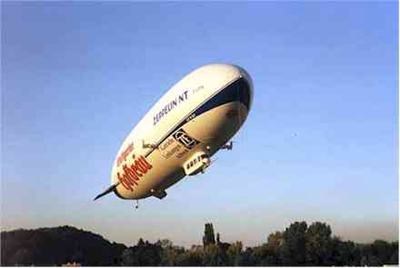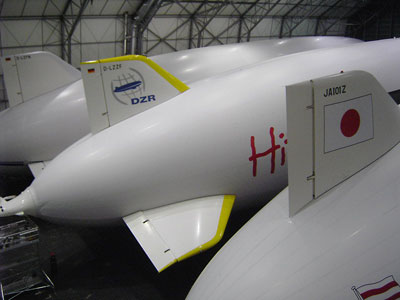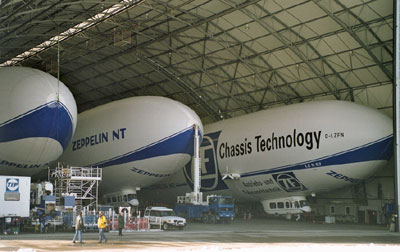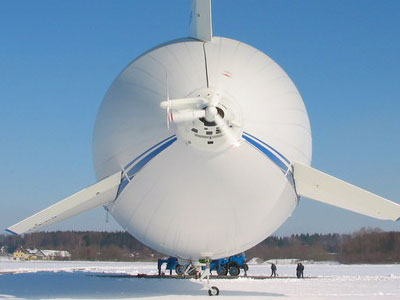The Zeppelin Airships
Part Four: The Zeppelin NT, Present and Future
SN-01 D-LZFN Friedrichshafen |
Class: |
NT-07 |
Usage: |
prototype / DZR |
First Flight: |
18 September 1997 |
Length: |
75 meters |
Diameter: |
19.5 meters |
Gas Volume: |
8,225 cu. meters |
Engines: |
Three 200 hp Textron Lycoming IO-360 engines |
Maximum Speed: |
125 kph |
Crew: |
2 |
Passengers: |
12 |
 |
The Zeppelin NT-07 (NT = Neuer Technologie) is an airship type first manufactured the 1990s by Zeppelin Luftschifftechnik GmbH (ZLG) in Friedrichshafen. ZLG was founded as a joint venture of Zeppelin, which today distributes Caterpillar heavy construction equipment, and ZF, which manufactures transmissions.
The initial design study was prepared in 1989. ZLG was founded in September 1993 and began to construct the prototype in 1995.
|

The Maiden Flight of SN-01, 18 September 1997
|
In standard operation mode, the airship's helium does not create enough buoyancy to make the whole ship "lighter-than-air", which is compensated for with engine power. It is therefore considered a hybrid airship. This condition can change when traveling with reduced payload and partially emptied fuel tanks, but usually the Zeppelin NT-07 flies with a remaining downward force of about 300 kg.
The Zeppelin NT-07 is a semi-rigid airship. It is fitted with a carbon fiber support structure of triangular cross-section and three longitudinal girders made of aluminium towhich engines, the control car and the steering fins are attached. Additionally, this structure is tightened with aramid cords. It has an approximate mass of only 1000 kg.
|

|
On 2 July 2000, the centennial of the first Zeppelin flight, SN-01 was christened D-LZFN Friedrichshafen. Since 15 August 2001 Deutsche Zeppelin Reederei (DZR), founded as a subsidiary company of ZLG, has successfully offered joyrides with Zeppelin NT-07 airships. The hull surfaces are marketed as advertising space.
Additionally, the craft are used as observation platforms for photographers and television commentators covering major events. Due to their capability for long low vibration flight (up to 24 hours), ZLG considers the airships well-suited to research missions for environmental observations, troposphere research or prospecting natural resources.
Friedrichshafen is intended to be used for training pilots, for special flights, and for generating advertising revenue.
|
SN-02 D-LZZR Bodensee (II) / JA101Z Yokoso Japan |
Class: |
NT-07 |
Usage: |
DZR / Nippon |
First Flight: |
10 August 2001 |
Length: |
75 meters |
Diameter: |
19.5 meters |
Gas Volume: |
8,225 cu. meters |
Engines: |
Three 200 hp Textron Lycoming IO-360 engines |
Maximum Speed: |
125 kph |
Crew: |
2 |
Passengers: |
12 |
 |
In 2001 the company began manufacturing the Zeppelin NT-07 in series. Bodensee started to carry passengers just five days after her maiden flight. By the end of that year, she had transported 3,222 passengers, a figure that rose to 30,000 by November of 2003.
During Oktoberfest of 2002 she conducted radio experiments with the European Galileo positioning system project for the German Aerospace Center and the ESA.
|

|
On 2 March 2004 ZLG sold SN-02 to the Japanese Nippon Airship Corporation. The company intends to use her mainly for joyrides and advertising.
|
SN-03 D-LZZF |
Class: |
NT-07 |
Usage: |
DZR |
First Flight: |
10 February 2003 |
Length: |
75 meters |
Diameter: |
19.5 meters |
Gas Volume: |
8,225 cu. meters |
Engines: |
Three 200 hp Textron Lycoming IO-360 engines |
Maximum Speed: |
125 kph |
Crew: |
2 |
Passengers: |
12 |
 |
The third Zeppelin NT-07 is used primarily for passenger flights around Lake Constance and for advertising.
|

|
|
Copyright ©2007 Puget Sound Airship Society
|
 |
|
